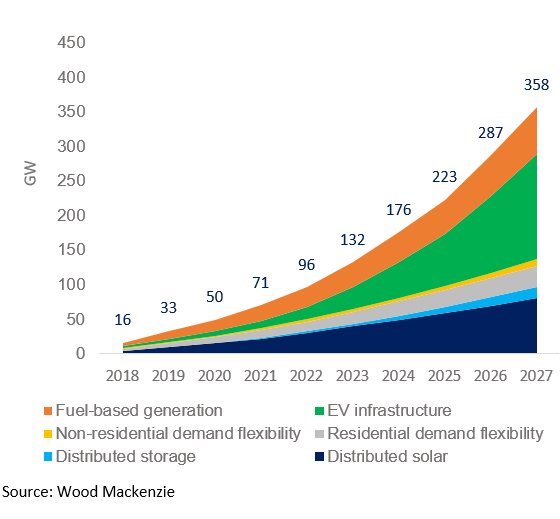
The US Distributed Energy Resource (DER) market is expected to nearly double in capacity from 2022 to 2027, with capital expenditure reaching US $68 billion per year, according to Wood Mackenzie’s ‘2023 US Distributed Energy Resource Outlook’ report.
This new analysis from Wood Mac shows that 262 GW of new DER and demand flexibility capacity will be installed from 2023 to 2027 — which is close to matching the 272 GW of utility-scale resource installations also expected during that period.
“Federal incentives, headlined by the Inflation Reduction Act tax credits and National Electric Vehicle Infrastructure grant program, represent the greatest catalysts for growth in the US DER market. Continued failure of system operators to reduce the time and cost of interconnection would be a tailwind, forcing utilities and corporates to look to distributed resources to achieve reliability and clean energy goals,” said Ben Hertz-Shargel, Global Head of Grid Edge at Wood Mackenzie, and lead author of the report.

The grid insecurity of homeowners and business owners represents the strongest demand pull, which will cause the distributed fuel-based generation market to grow 240% from 2022 to 2027, and the distributed storage market to soar 460%, with storage reaching nearly US $10 billion per year.
EV charger capacity to overtake DG solar for first time
Electric Vehicle (EV) charger annual installed capacity will overtake distributed solar for the first time in 2023 and will reach 41 GW by 2027, more than three times the expected solar annual additions that year.
To meet this growth in capacity, the EV charging infrastructure market will reach $20 billion by 2027, led by the residential Level 2 (US $6.5 billion) and public dc fast-chargers (US $5.6 billion) segments.
While most of the charging capacity will always be residential, that share will decrease due to growth in infrastructure for buses and trucks, which will reach 18% of total charging capacity by 2027, according to Wood Mackenzie’s outlook report.
Despite a price decline of 13% over the next five years, distributed solar will still represent 46% of DER capital expenditure through 2027. California’s Net Billing Tariff will be a doubled-edged sword for solar providers, causing a 38% contraction of the market in 2024 but significantly increasing storage attachment rates going forward.
Demand flexibility growth uneven
Summer flexible capacity from smart thermostats will nearly double from 2022 to 2027, reaching 34 GW. But this capacity will not translate to winter, as advanced heat pump technology and mini-splits are not yet DR-enabled. After years of stagnation, the grid-interactive water heater market will grow eightfold over the forecast period, driven by energy efficiency policies across western states.
Industrial and manufacturing flexibility will reach 45 GW by 2027, 33% more than that of commercial buildings. Small building flexibility remains hampered by only 17% penetration of building automation systems, investments that are supported by generous IRA energy efficiency incentives but will be discouraged by elevated interest rates.
DER defined
DER capacity refers to the alternating current nameplate power capacity of fuel-based generation, storage, and EV charging assets, and direct current nameplate capacity for solar assets. The definition of DER varies across the industry. For this report, Wood Mackenzie defines DERs as:
- Customer-sited – Resources located physically on a customer premise, whether that premise is interconnected at the distribution or transmission level. Community-owned assets on the distribution system are also included.
- Primary use – No maximum MW capacity is applied, but we enforce a primary use restriction, under which, to be included, a resource must serve or control a customer(s)’ local load for electricity and, potentially, heat. Community-owned assets are considered as satisfying.
- Embodiment – A DER must be embodied as a physical asset, whose primary purpose is energy management. Flexibility in customer energy demand, including the willingness to raise temperature setpoints or shut down production lines, is not considered a DER.
- Voltage – A voltage restriction of 69 kV is used for non-CHP generators. This includes all EV infrastructure deployments, which are connected at distribution grid voltages.
— Solar Builder magazine

Leave a Reply
You must be logged in to post a comment.